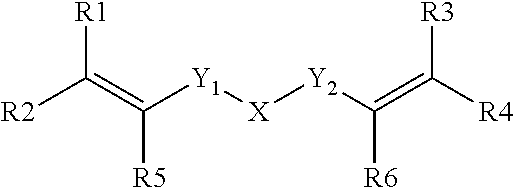Dental composition
a technology of dental glass and composition, applied in dentistry, dental prosthetics, impression caps, etc., can solve the problems of bulk fracture of restorations, low flexural strength, and fracture at the edges of restorations, and achieve the effect of improving flexural strength
- Summary
- Abstract
- Description
- Claims
- Application Information
AI Technical Summary
Benefits of technology
Problems solved by technology
Method used
Image
Examples
example 1
Preparative Example 1
Synthesis of polytetrahydropyran-3,5-dicarboxylic acid
1. Synthesis of 2-hydroxymethacrylic acid ethylester
[0158]
[0159]In a 100 ml flask, 10.0 g (0.1 mol) acrylic acid ethyl ester, 2.2 g (0.072 mol) paraformaldehyde and 0.80 g (7.2 mmol) 1,4-diazabicyclo[2.2.2]octane are introduced and stirred over a period of several days a root temperature. The originally turbid reaction mixture turns eventually clear. The raw product is purified by flash chromatography (ethyl acetate / hexane, 1:1). The fractions are combined, hydrochinone is added and the solvent is removed under vacuum. A clear liquid is obtained.
Fraction 2 to 7:
[0160]IR: 2982, 2936, 2910, 2872 (ν, —CH3, —CH2), 1710 (ν, —COOR), 1637 (ν, —C═C), 1460, 1447, 1375 (δ, —CH3, —CH2), 1156, 1093 (ν, —C—O—C—), 948 (ν, RCH═CH2) cm−1.
[0161]1H-NMR (500 MHz, CDCl3): d 6.31, 5.89 (8, 4H, RC—CH═CH2), 4.25 (s, 4H, RC—CH2—O—CH2—CR), 4.22 (q, 4H, RCO—CH2—CH3), 1.30 (t, 6H, RC—CH3) ppm.
[0162]GC / MS: m / z 197 (C10H13O4+), 169 (C9H1...
example 2
Preparative Example 2
Synthesis of poly-1,3-diethyl-5,5-dimethylcyclohexane-1,3,5,5-tetracarboxylate
1. Synthesis of 2-bromomethylacrylic acid ethyl ester
[0188]
[0189]In a 100 ml flask equipped with a magnetic stirrer, a dropping funnel, and a drying tube, 2.3 g (17.7 mmol) 2-hydroxymethacrylic acid ethylester are added to 10 mL absolute diethyl ether. Under ice cooling, 1.92 g (7.08 mmol) phosphorous tribromide in 5 mL absolute diethylether are added dropwise. After 18 hours of stirring at room temperature, any excess phosphorous tribromide is hydrolysed by addition of 10 mL of water under ice cooling. The organic layer is washed twice with saturated NaHCO3 solution, dried over Na2SO4 and stabilized with a small amount of hydrochinon. Diethyl ether is removed under vacuum.
[0190]IR: 2981, 2933, 2901, 2869 (ν, —CH3, —CH2), 1718 (ν, —COOR), 1628 (ν, —C═C), 1463, 1444, 1398 (δ, —CH3, —CH2), 1182, 1115 (ν, —C—O—), 957 (ν, RCH═CH2), 607 (ν, C—Br) cm−1.
[0191]GC / MS: m / z 192 (M-H+), 164 (C4H6B...
example 3
Preparative Example 3
Synthesis of a Cyclocopolymer from Divinylether and Maleic Acid Anhydride (DIVEMA)
[0201]1. Synthese von Divinylether
[0202]In a 100 mL two-neck flask equipped with a magnetic stirrer and a distillation bridge, 9.39 g (83.7 mmol) potassium tert-butylat in 40 mL wasserfreiem tert-Butanol are introduced and heated to 50° C. By using a septum, 6.0 g (41.9 mmol) 2-chloroethyl ether is added dropwise to the mixture which is heated to 100° C. erhitzt. The reaction mixture becomes turbid. The Die distillation head is cooled with acetone / dry ice.
[0203]GC / MS: m / z 70 (M+), 44 (C2H4O2+), 43 (C2H30+), 31 (CH3O+), 27 (C2H3+).
[0204]1H-NMR (200 MHz, CDCl3): d 6.51-6.41 (dd, 2H, RO—CH═CH2), 4.62-4.54 (dd, 2H, RO—CH═CH2), 4.29-4.25 (dd, 2H, RO—CH═CH2) ppm.
[0205]2. Synthesis of a Cyclocopolymer from Divinyl Ether Und Maleic Acid Anhydride (DIVEMA)
[0206]In a 25 mL flask equipped with a magnetic stirrer, 0.5 g (7.13 mmol) divinylether is introduced. Under cooling with ice, an argon s...
PUM
| Property | Measurement | Unit |
|---|---|---|
| Percent by mass | aaaaa | aaaaa |
| Percent by mass | aaaaa | aaaaa |
| Percent by mass | aaaaa | aaaaa |
Abstract
Description
Claims
Application Information
 Login to View More
Login to View More - R&D
- Intellectual Property
- Life Sciences
- Materials
- Tech Scout
- Unparalleled Data Quality
- Higher Quality Content
- 60% Fewer Hallucinations
Browse by: Latest US Patents, China's latest patents, Technical Efficacy Thesaurus, Application Domain, Technology Topic, Popular Technical Reports.
© 2025 PatSnap. All rights reserved.Legal|Privacy policy|Modern Slavery Act Transparency Statement|Sitemap|About US| Contact US: help@patsnap.com



